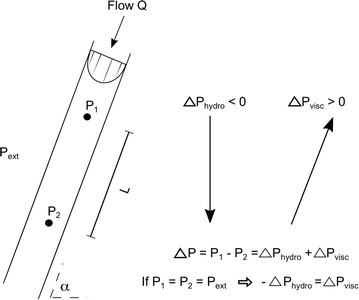Fig. 1.

Description of pressure in a collapsed vessel. The description is based on the assumption of zero transmural pressure in the collapsed jugular vein. Thus, to achieve zero transmural pressure in the collapsed section of the vessel the internal pressures at any two levels 1 and 2 must be equal to the external pressure, i.e. P 1 = P 2 = P ext. This means that internal pressure cannot change along the vein from level 1 to level 2 and the pressure (hydrostatic and viscous) components must cancel each other in this segment. The arrows indicate the direction of increasing pressure for the two pressure components inside the vessel. L is the distance between the two points in question and α is the tilt angle of the vessel. Since near-zero (i.e. near atmospheric) pressures are expected around the IJVs [24, 28, 29], the internal pressure should also be near-zero after collapse
